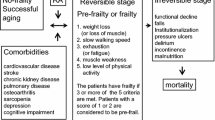Abstract
This study aims to compare the efficacy and safety of anti-TNF agents in elderly (aged ≥65 years) and younger patients (aged 18–65 years) with active RA. The study involved 1,114 RA patients treated with anti-TNF drugs and followed-up for >6 months by LORHEN group, who were divided into two cohorts on the basis of their age (311 aged ≥65 and 803 aged <65 years) in order to evaluate 3-year outcomes and treatment discontinuations. Drug effectiveness was assessed by disease activity (DAS28 and EULAR response), functional status (HAQ) and serological parameters (ESR) at baseline and during anti-TNFα therapy; safety was evaluated on the basis of drug discontinuation rates. At baseline, the elderly patients showed greater disease activity (DAS28, ESR) and loss of joint function (HAQ, functional class; p < 0.05). During therapy, clinical and laboratory parameters (DAS28, ESR) improved in both groups without any statistically significant difference between them, whereas the difference in HAQ remained after 36 months of treatment (p < 0.05). Anti-TNFα therapy was discontinued by 123 of the elderly (42%) and 282 of the younger patients (36.6%) because of loss of efficacy (17.4% vs. 16.7%), severe adverse events (21.8% vs. 16.9%) or other reasons (2.7% vs. 3%). The number of adverse events was significantly higher in the elderly patients (p < 0.05). Anti-TNFα treatment reduced disease activity and led to functional improvement in both groups, although the baseline difference in HAQ remained statistically significant at the end of the follow-up. The elderly patients experienced more infective events.



Similar content being viewed by others
References
Cimmino MA, Parisi M, Moggiana G, Mela GS, Accardo S (1998) Prevalence of rheumatoid arthritis in Italy: the Chiavari study. Ann Rheum Dis 57:315–318
van Schaardenburg D, Lagaay AM, Breedveld FC, Hijmans W, Vandenbroucke JP (1993) Rheumatoid arthritis in a population of persons aged 85 years and over. Br J Rheumatol 32:104–109
Deal CL, Meenan RF, Goldenberg DL, Anderson JJ, Sack B, Pastan RS, Cohen AS (1985) The clinical features of elderly-onset rheumatoid arthritis. A comparison with younger-onset disease of similar duration. Arthritis Rheum 28:987–994
van Schaardenburg D, Breedveld FC (1994) Elderly-onset rheumatoid arthritis. Semin Arthritis Rheum 23:367–378
Olivieri I, Palazzi C, Peruz G, Padula A (2005) Management issues with elderly-onset rheumatoid arthritis. An update. Drugs Aging 22:809–822
Fleischmann RM, Baumgartner SW, Tindall EA, Weaver AL, Moreland LW, Schiff MH et al (2003) Response to etanercept (Enbrel) in elderly patients with rheumatoid arthritis: a retrospective analysis of clinical trial results. J Rheumatol 30:691–696
Dahl SL, Samuelson CO, Williams HJ, Ward JR, Karg M (1990) Second-line antirheumatic drugs in the elderly with rheumatoid arthritis: a post hoc analysis of three controlled trials. Pharmacotherapy 10:79–84
Arnett FC, Edworthy SM, Bloch DA, McShane DJ, Fries JF, Cooper NS et al (1998) The American Rheumatism Association 1987 revised criteria for the classification of rheumatoid arthritis. Arthritis Rheum 31:315–324
Valesini G, Montecucco C, Cutolo M (2006) Recommendations for the use of biologic (TNF-alpha blocking) agents in the treatment of rheumatoid arthritis in Italy. Clin Exp Rheumatol 24:413–423
On behalf of the EULAR standing committee for international clinical studies including therapeutic trials, Van Riel PLCM, van Gestel AM, Scott DL (2000) The EULAR handbook of clinical assessment in rheumatoid arthritis. Van Zuiden Communications, Alpen an den Rijn
Ranza R, Marchesoni A, Calori G, Bianchi G, Braga M, Canazza S et al (1993) The Italian version of the functional disability index of the health assessment Questionnaire. A reliable instrument for multicenter studies on rheumatoid arthritis. Clin Exp Rheumatol 11:123–128
Bathon JM, Fleischmann RM, Van der Heijde D, Tesser JR, Peloso PM, Chon Y, White B (2006) Safety and efficacy of etanercept treatment in elderly subjects with rheumatoid arthritis. J Rheumatol 33:234–243
Aletaha D, Ward MM (2006) Duration of rheumatoid arthritis influences the degree of functional improvement in clinical trials. Ann Rheum Dis 65:227–233
Kauppi M, Hartikainen S, Kautiainen H, Laiho K, Sulkava R (2005) Capability for daily activities in old people with rheumatoid arthritis: a population based study. Ann Rheum Dis 64:56–58
Genevay S, Finckh A, Ciurea A, Chamot AM, Kyburz D, Gabay C (2007) Tolerance and effectiveness of anti-tumor necrosis factor alpha therapies in elderly patients with rheumatoid arthritis: a population-based cohort study. Arthritis Rheum 57:679–685
Gorla R, Cavagnola L.2004. Approccio multidisciplinare nel trattamento dell’AR. In La riabilitazione nelle malattie reumatiche. Percorsi clinici, progetto e programma riabilitativo. Edited by Mattioli 1885. Fidenza pp 316-324.
Yung RL (2000) Changes in immune function with age. Rheum Dis Clin North Am 26:455–473
Askling J, Bongartz T (2008) Malignancy and biologic therapy in rheumatoid arthritis. Curr Opin Rheumatol 20:334–349
Geborek P, Bladstrom A, Turesson C, Gulfe A, Peterson IF, Saxne T, Olsson H, Jacobsson LTH (2005) Tumour necrosis factor blockers do not increase overall tumour risk in patients with rheumatoid arthritis, but may be associated with an increased risk of lymphomas. Ann Rheum Dis 64:699–703
Author information
Authors and Affiliations
Corresponding author
Additional information
All of the authors have received consultancy fees or congress invitations from Schering-Plough, Weyth and Abbot.
Rights and permissions
About this article
Cite this article
Filippini, M., Bazzani, C., Favalli, E.G. et al. Efficacy and Safety of Anti-Tumour Necrosis Factor in Elderly Patients with Rheumatoid Arthritis: An Observational Study. Clinic Rev Allerg Immunol 38, 90–96 (2010). https://doi.org/10.1007/s12016-009-8142-1
Published:
Issue Date:
DOI: https://doi.org/10.1007/s12016-009-8142-1




